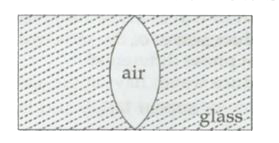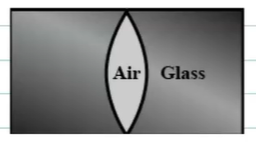A spherical surface of radius of curvature R separates air (refractive index 1.0) from glass (refractive index 1.5). The centre of curvature is in the glass. A point object P placed in air is found to have a real image Q in the glass. The line PQ cuts the surface at a point O, and PO=OQ. The distance PO
5R
3R
2R
1.5R
The correct Answer is:A
To solve the problem, we will follow these steps:
Step 1: Understand the Geometry
We have a spherical surface separating air (n1 = 1.0) and glass (n2 = 1.5). The center of curvature (C) is located in the glass. A point object P is in air, and it forms a real image Q in glass. The line PQ intersects the spherical surface at point O, and it is given that PO = OQ.
Step 2: Define Variables
Let:
- PO = x (distance from the object P to point O)
- OQ = x (distance from point O to the image Q)
Thus, the total distance PQ = PO + OQ = x + x = 2x.
Step 3: Apply the Refraction Formula
Using the formula for refraction at a spherical surface:
n2v−n1u=n2−n1R
where:
- n1=1.0 (refractive index of air)
- n2=1.5 (refractive index of glass)
- u=−2x (object distance, negative as per sign convention)
- v=x (image distance, positive as the image is real)
Step 4: Substitute Values into the Formula
Substituting the values into the refraction formula:
1.5x−1.0−2x=1.5−1.0R
This simplifies to:
1.5x+0.52x=0.5R
1.5x+0.25x=0.5R
Combining the fractions on the left gives:
1.75x=0.5R
Step 5: Rearranging to Find x
Cross-multiplying gives:
1.75R=0.5x
Rearranging for x:
x=1.75R0.5=3.5R
Step 6: Conclusion
Since PO = x, we find that:
PO=3.5R
Final Answer
Thus, the distance PO is 3.5R.
---
We have a spherical surface separating air (n1 = 1.0) and glass (n2 = 1.5). The center of curvature (C) is located in the glass. A point object P is in air, and it forms a real image Q in glass. The line PQ intersects the spherical surface at point O, and it is given that PO = OQ.
Let:
- PO = x (distance from the object P to point O)
- OQ = x (distance from point O to the image Q)
Thus, the total distance PQ = PO + OQ = x + x = 2x.
Using the formula for refraction at a spherical surface:
n2v−n1u=n2−n1R
where:
- n1=1.0 (refractive index of air)
- n2=1.5 (refractive index of glass)
- u=−2x (object distance, negative as per sign convention)
- v=x (image distance, positive as the image is real)
Substituting the values into the refraction formula:
1.5x−1.0−2x=1.5−1.0R
This simplifies to:
1.5x+0.52x=0.5R
1.5x+0.25x=0.5R
Combining the fractions on the left gives:
1.75x=0.5R
Cross-multiplying gives:
1.75R=0.5x
Rearranging for x:
x=1.75R0.5=3.5R
Since PO = x, we find that:
PO=3.5R
Thus, the distance PO is 3.5R.
Topper's Solved these Questions
Similar Questions
A convex surface of radiys of curvature 20 cm separates air from glass of refractive index 1.5. Find the position and the nature of the image of a small object placed at 50 cm in front of the convex surface.
View SolutionIn figure, an air lens of radius of curvature of each surface equal to 10cm is cut into a cylinder of glass of refractive index 1.5. The focal length and the nature of lens are
View Solution
Knowledge Check
A spherical surface of radius of curvature R separates air (refractive index 1.0) from glass (refractive index 1.5). The center of curvature is in the glass. A point object P placed in air is found to have a real image Q in the glass. The ling PQ cuts the surface at a point O, and PO=OQ. The distance PO is equal to
A5RB3RC2RD1.5RIn the figure, an air lens is cut a cylinder of glass of refractive index 1.5 . The nature of the lens is
 AdiverigingBconvergingCneither diverging nor convergingDnone of these
AdiverigingBconvergingCneither diverging nor convergingDnone of theseA plano convex lens is made of glass of refractive index 1.5. The radius of curvature of its convex surface is R. Its focal length is
AR2BRC2RD1.5R
A plano-convex lens is made of glass of refractive index 1.5. The radius of curvature of its convex surface is R. Its focal length is
View SolutionA plano-convex lens is made of glass of refractive index 1.5. the radius of curvature of its convex surface is R. its focal length is
View SolutionAn equiconvex lens is prepared from a glass of refractive index, 1.5 . The radius of curvature of the surface is 0.5 m. The focal length of the lens is
View SolutionAn image is formed at a distance of 100 cm from the glass surface with refractive index 1.5, when a point object is placed in the air at a distance of 100 cm from the glass surface. The radius of curvature is of the surface is
View SolutionA spherical convex surface separates object and image space of refractive index 1 and 43 respectively. If radius of curvature of the surface is 0.1 m, its power is
View Solution
